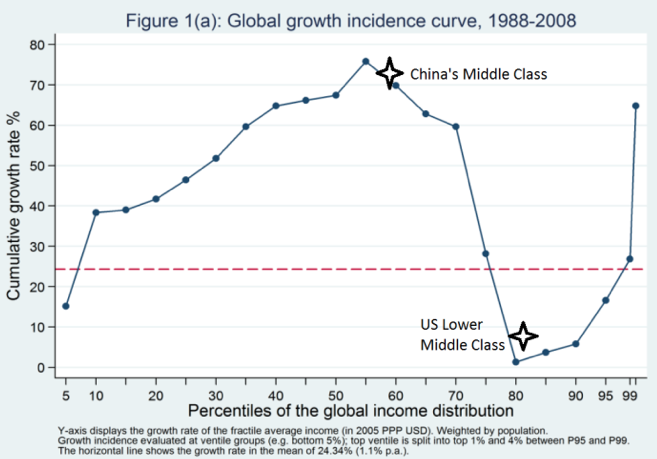Welcome to DU!
The truly grassroots left-of-center political community where regular people, not algorithms, drive the discussions and set the standards.
Join the community:
Create a free account
Support DU (and get rid of ads!):
Become a Star Member
Latest Breaking News
General Discussion
The DU Lounge
All Forums
Issue Forums
Culture Forums
Alliance Forums
Region Forums
Support Forums
Help & Search
Drivers of inequality: Trade shocks versus top marginal tax rates
http://voxeu.org/article/drivers-inequality-trade-versus-tax-ratesDouglas Campbell, Lester Lusher
Growing wealth inequality has been one of the most pressing political issues since the Great Recession. However, there is a relative lack of consensus on the significant drivers of this trend. This column investigates the contribution of globalisation, via international trade, to US wealth inequality. Although trade is found to have had important effects on certain parts of the US labour market in the early 2000s, the growth in US inequality since 1980 can be traced back to Reagan-era tax cuts.
Do trade shocks cause inequality? Figure 1 (originally from Lakner and Milanovic 2013) was Paul Krugman’s ‘chart of the year’ for 2014. It shows that the percentiles of the world’s income distribution coinciding with the lower-middle class in the US and other developed countries saw their incomes grow slowly from 1988 to 2008. Over the same period, the upper-middle classes in China and India experienced rapid income growth as millions of people were lifted out of poverty. The obvious question to ask is whether globalisation was a significant cause of the slow growth in lower-middle class incomes in the US and other developed economies.
Figure 1. Global growth incidence curve, 1988-2008

This is an especially pertinent question given that recent research – including Autor et al (2013), Pierce and Schott (2015), and Ebenstein et al. (2012) – indicates that the rise of China had a large impact on American manufacturing in the early 2000s. Campbell (2016) finds that the dollar’s sharp appreciation in the late 1990s and early 2000s also contributed to manufacturing’s surprisingly sudden collapse. Autor et al. (2014), in what is a seminal paper in the trade and inequality literature, find that higher-wage workers exposed to Chinese competition were easily able to move employers and to limit earnings declines, but that lower-wage workers were not.
However, it is also the case that inequality in the US increased more in the 1980s and early 1990s – before trade with China was large enough to have had a major impact on the income distribution – than it has since. Thus, to try to understand how much trade shocks have increased inequality, in a recent paper we use three distinct and complementary methods (Campbell and Lusher 2016). First, we recognise that the volatile history of US relative prices can help with the problem of identification. Figure 2 below shows that in periods when the dollar appreciates, imports surge relative to exports. It’s also the case that not all sectors are equally affected. Some sectors, such as concrete manufacturing, are inherently less exposed to international trade than furniture. Thus, our methodology will be to compare workers in sectors which are more versus less exposed to trade in periods of trade shocks versus other periods.
. . . more
InfoView thread info, including edit history
TrashPut this thread in your Trash Can (My DU » Trash Can)
BookmarkAdd this thread to your Bookmarks (My DU » Bookmarks)
1 replies, 835 views
ShareGet links to this post and/or share on social media
AlertAlert this post for a rule violation
PowersThere are no powers you can use on this post
EditCannot edit other people's posts
ReplyReply to this post
EditCannot edit other people's posts
Rec (1)
ReplyReply to this post
1 replies
 = new reply since forum marked as read
Highlight:
NoneDon't highlight anything
5 newestHighlight 5 most recent replies
= new reply since forum marked as read
Highlight:
NoneDon't highlight anything
5 newestHighlight 5 most recent replies
Drivers of inequality: Trade shocks versus top marginal tax rates (Original Post)
swag
Sep 2016
OP
rogerashton
(3,920 posts)1. Notice a shift here from inequality of wealth to inequality of income.
They are interrelated. However, inequality of income comes from three sources: inequality of wealth (with consequent inequality of income generated by profits); inequality of wages; and inequality in opportunities to work or to acquire income or wealth. There are different causes operating on these three. Inequality of wages has been impacted by globalization. Inequality of wealth has been influenced by the tax cuts -- read Piketty to understand how. The incomes of people who have neither wealth nor any opportunity to work have been made very much worse by the "welfare reforms" created by agreement "across the aisle" in the 1990's.
Not either-or. All-and instead.